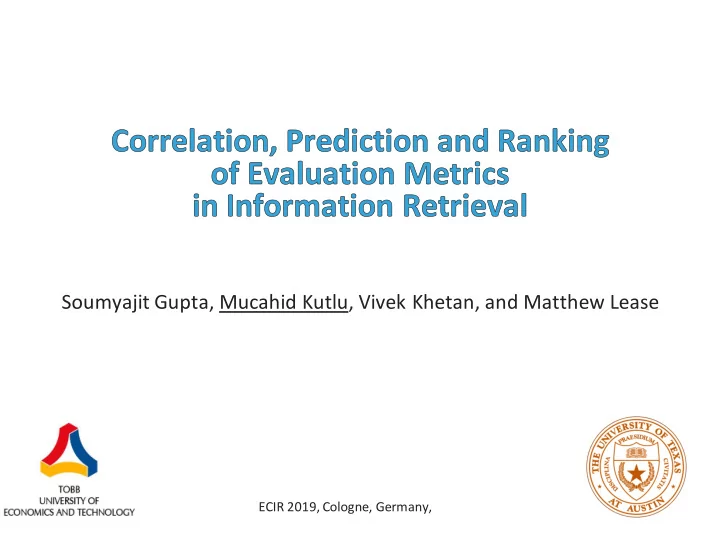

Soumyajit Gupta, Mucahid Kutlu, Vivek Khetan, and Matthew Lease ECIR 2019, Cologne, Germany,
So many metrics… 2 ▸ More than 100 metrics ▸ Limited time and space to report all
Which ones should we report?
Challenge in system comparisons 4 Taken from two different papers If paper A reports metric X and paper B reports metric Y on the same collection, how can I know which one is better?
Some ideas.. 5 ▸ Run them again on the collection ▸ Do they share their code? ▸ Implement the methods ▸ Is it well explained in the paper? ▸ Check if there is any common baseline used against and compare indirectly?
Our Proposal 6 ▸ Wouldn’t be nice to predict a system performance based on metric X using its performance on other metrics as features? ▸ Here is the general idea ▸ Build a classifier using only metric scores as features ▸ Predict the unknown metric using the known ones ▸ Compare systems based on predicted score with some confidence value ▸ Going back to our example: ▸ Predict A’s P@20 score using its MAP, P210, P@30 and NDCG score ▸ Compare A’s predicted P@20 with B’s actual P@20
Correlation between Metrics 7
Prediction 8 ▸ Goal: investigate which K evaluation metric(s) are the best predictors for a particular metric ▸ Training data: System average scores over topics in WT2000-01, RT2004, WT2010-11 collections. ▸ Test data: WT2012, WT2013, and WT2014 ▸ Learning algorithms: Linear Regression and SVM ▸ Approach: ▸ For a particular metric, we try all combinations of size K using other evaluation metrics on WT2012 ▸ Pick the highest and apply it on WT2013 and WT2014
Prediction Results 9
Which metrics should I report?
Ranking Metrics 11 ▸ Metrics do have correlation ▸ Why do we need to report correlated ones? ▸ Goal: Report the most informative set of metrics ▸ NP-Hard problem ▸ Iterative Backward Strategy: ▸ Start with a full set of covariance of metrics ▸ Iteratively prune less informative ones ▸ Remove the one that yields maximum entropy without it ▸ Greedy Forward Strategy ▸ Start with a empty set ▸ Greedily add most informative ones ▸ Pick the metric that is most correlated with all the remaining ones
Metrics ranked by each algorithm 12
Conclusion 13 ▸ Quantified correlation between 23 popular IR metrics on 8 TREC test collections ▸ Showed that accurate prediction of MAP, P@10, and RBP can be achieved using 2-3 other metrics ▸ Presented a model for ranking evaluation metrics based on covariance, enabling selection of a set of metrics that are most informative and distinctive.
Thank you! 14 This work was funded by the Qatar National Research Fund, a member of Qatar Foundation.
Recommend
More recommend